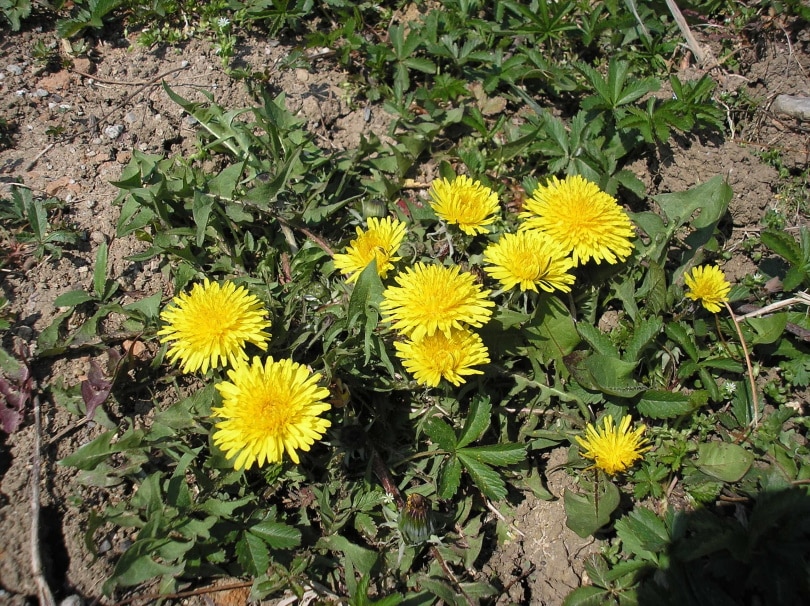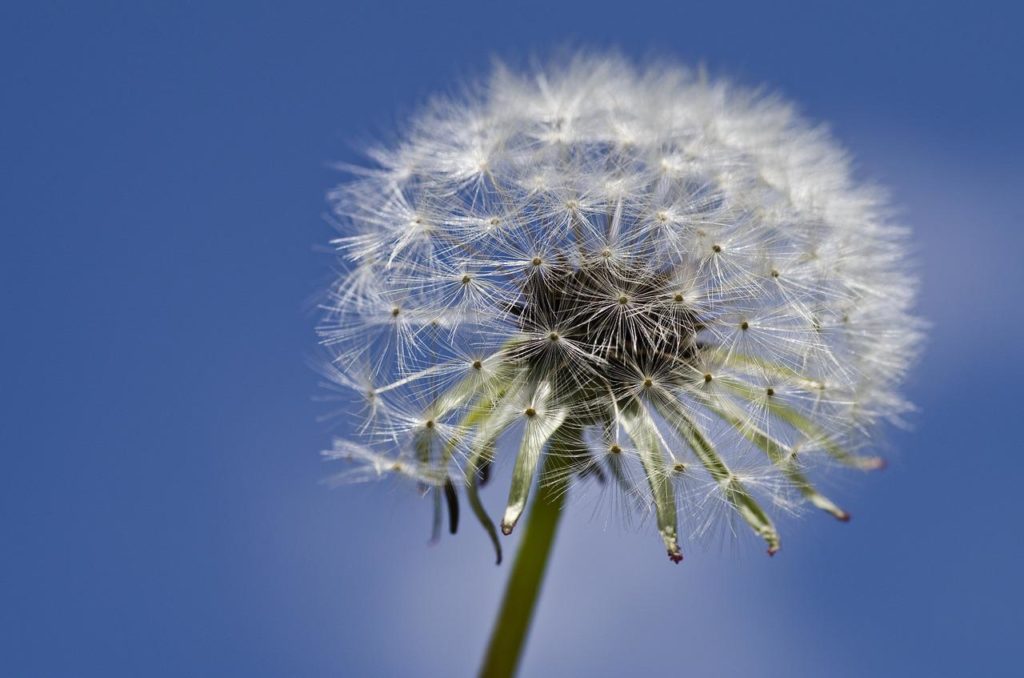Are Dandelions Weeds? Facts, Uses & Removal
-
Pete Ortiz
- Last updated:

Almost everyone can identify a dandelion. It’s an omnipresent plant with a long green stem, bright yellow flower top, and beautiful quaint seeds. The beauty of the seed is so mesmerizing that in 2019, director Jill Culton featured a dandelion flower in one of the most famous scenes of the animated movie “Abominable”.
Dandelions are, however, controversial plants sharing a love-hate relationship with gardeners, which sparks the debate: Are dandelions weeds? Both proponents and opponents might give valid arguments, but, technically, a dandelion is a weed. A quick search from the USDA Federal Noxious List will corroborate this assertion.
According to the Merriam-Webster dictionary, weeds are defined as plants that grow where they are not valued and tend to overgrow, choking out the desired plants. By this definition, unless you have intentionally grown dandelions for consumption or aesthetic purposes, then they are considered weeds.
Read on to find out everything you need to know about dandelions.
 How Do You Classify a Dandelion?
How Do You Classify a Dandelion?
The scientific name of a common dandelion is Taraxacum officinale. The term “Taraxacum” is derived from the Arabic word “tarakshaqun”, which roughly translates to “bitter herb”. So, using this logic, the plant name suggests that dandelion is more of an herb than a weed. Many botanists support this logic because a dandelion plant is rich in vitamins and flaunts tremendous healing powers.
Florists contend that it is a wildflower. This is a solid argument because dandelions are members of the aster family, the biggest plant family on the planet. The members of the aster family have characteristics that we would consider flowers.
But, in essence, the common dandelion (Taraxacum officinale) is a weed because it shares similar characteristics with other weed plant varieties. It spreads like a bush fire, isn’t native to the US, and is hard to eradicate.

Why a Dandelion Is Considered a Weed
Dandelions are a very invasive plant species that are difficult to control. They can be spread via seeds, roots, or root segments. A firm stem and deep taproots also give them an advantage over other weed varieties. Aside from that, it is also a perennial plant that can revive from even the smallest root segment.
A dandelion can firmly root itself to the ground, so much so that regular lawn mowing will not get rid of them completely. Cutting an inch below the surface won’t cut it either. Like Lernaean Hydra, the famous mythical Greek Monster, you cut one shoot, and another one grows in its place.
Also, unlike other garden variety plants, dandelions have strong taproots that can grow up to 15 feet in optimum conditions. The taproots allow the plant to get nutrients from deep in the soil, even in dry seasons or when the shoot has been cut.
Moreover, the plant has parachute-like seeds, which are so light and buoyant that they can travel long distances with just a slight breeze. They can quickly expand their territory in just a matter of days.
Another weedy characteristic of a dandelion is its ability to grow in most soil types. You will get these plants asserting their dominance in bare desert soil, grass-covered savannahs, compacted soil, and even your front lawn. If the plant’s wind-dispersed seeds land on fertile soil, dandelions thrive and spread so fast that they can hamper the growth of your turf grass. This is probably why landscapers cringe at the sight of a dandelion on their beautifully manicured lawns.
When a Dandelion Is Not Considered a Weed
Let’s revisit the earlier definition of a weed. In a nutshell, plants are considered weeds if they grow where they are not needed and have vigorous growth that can disrupt the development of surrounding plants. In this regard, dandelions will not be considered weeds if they are intentionally grown as a food source, for medicinal purposes, or as decorative plants.
Did you know that all the parts of a dandelion can be consumed? Yes, indeed they can.
- For many years, people have been creating different recipes for foods and drinks with dandelions as the main ingredient. The leaves of a dandelion can be blanched or sauteed and served as a salad. Crushed seeds and dry leaves are also added to coffee and tea to make a tasty beverage. Even today, dandelions are still marketed as food and drink ingredients that can be purchased from a local grocery store.
- Dandelion parts are an important source of body nutrients, such as magnesium, potassium, iron, calcium, and folate. They also contain Vitamins A, C, K, E, and a small dose of Vitamin B. The nutrient-rich makeup makes dandelions a great addition to the human diet with many health benefits. This is perhaps why dandelions were used as traditional medicines for various ailments before the 19th century.
- Apart from making exciting food recipes, dandelion flowers can also be mixed with wine yeast and fermented to make wine. The dandelion petals can add a pleasant flavor to your drink. The alcohol content of the dandelion wine is approximately 13%, potent enough to keep you intoxicated for a while.
- Dandelion plants are also used in the cosmetic industry to make beauty products.
The various benefits that a dandelion offers encourage people to propagate and grow them. This is probably why they were allowed to grow next to human settlements. This was before their popularity declined in the 19th and 20th centuries.
However, as years went by, the need to grow them was replaced by the desire to grow and tend to manicured lawns and gardens. This shifted the perception of dandelions from beautiful and useful plants to nuisances that needed to be dealt with. Since then, dandelions have been considered landscaping nightmares by many.

How Do You Eradicate Dandelions?
When dandelions become a nuisance, there are several ways of eradicating them from your lawn. The ideal method will depend on their population and growing position in your yard. As aforementioned, the anatomy of a dandelion prevents the application of standard weed whacking procedures.
You need a unique approach that guarantees total eradication because, otherwise, it would be a fool’s errand.
- Dig Them Out: Sure, you can uproot a few dandelions from your yard when manicuring your lawn. It may be an awkward and time-consuming endeavor, but it helps reduce gardening chores and keep your lawns looking neat. However, uprooting is just a band-aid solution because the plant will grow back from the remaining root segment. Fortunately, a dandelion dagger or a simple weed knife can dig out the entire plant and any remaining root segment. Before digging, wet the soil until the particles loosen, then slowly dig out the plant. After removing the root, cover the hole and plant some grass seed to discourage the growth of other weeds on the bare patch
- Spot Treat: This method utilizes post-emergent herbicides to selectively target and destroy a few populations of dandelions growing in your yard. A few herbicide varieties can spot-treat established dandelions by killing the roots. This is the best method to eradicate young dandelion plants before their roots burrow deeper into the ground. Be very cautious when using this method to eradicate dandelions. Some chemical herbicides can damage sensitive grass species, such as St. Augustine grass. So, use herbicide brands that don’t react with your grass species when treating your lawn. For clarification, consult the label instructions that come with the weed killer. You can also spot-treat with hot water. Dousing dandelions with hot water denatures the plant cells to the root, killing the plant. This is a natural and cheaper alternative, but you also need to be careful how you treat it with hot water to avoid burning your grass.
- Treat Entire Lawn: In case your lawn is overrun by dandelion infestations, you may have to take more drastic measures. Spray the entire lawn with a weed control treatment to eradicate large populations of dandelions. The best time to treat your entire lawn is in late fall or early spring. This is because dandelion seeds germinate and sprout during this season and are still weak. You only need to spray herbicides on dandelion shoots to clear them from your yard. This weed control treatment method can be harmful to your health and the environment. Consult your state guidelines and manufacturer instructions regarding using herbicides as weed killers.
There are two types of herbicides you can use for lawn treatment: pre-emergent and post-emergent herbicides. Pre-emergent weed killers do not harm existing weeds but prevent new ones from germinating, while post-emergent clear all dandelions from your lawn. Your choice of herbicide will depend on the season and your landscaping needs.
 Conclusion
Conclusion
Dandelions are unique plants with several benefits to human beings. When intentionally grown for human consumption and as decorative plants, we can sometimes avoid calling it a weed. But technically, they are still weeds, as they possess all other weed species characteristics that are difficult to control.
If a few dandelions grow in specific spots on your lawn, remove the plants by digging them out or spot treating the affected area. But, if the population of dandelions is large, treat the entire lawn to kill existing plants and prevent new shoots from growing on your lawn.
Featured Image Credit: JumpStory
Contents

 How Do You Classify a Dandelion?
How Do You Classify a Dandelion?